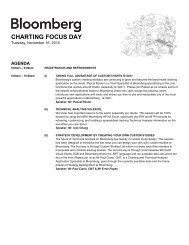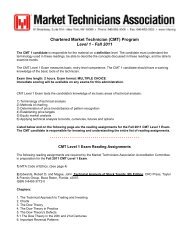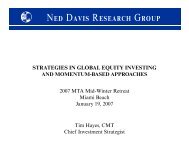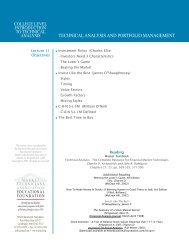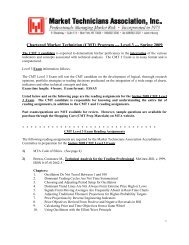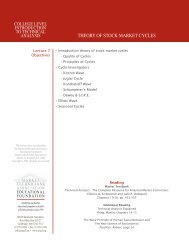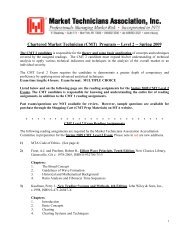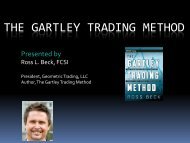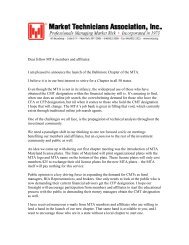Journal of Technical Analysis - Market Technicians Association
Journal of Technical Analysis - Market Technicians Association
Journal of Technical Analysis - Market Technicians Association
You also want an ePaper? Increase the reach of your titles
YUMPU automatically turns print PDFs into web optimized ePapers that Google loves.
6<br />
Roll <strong>of</strong> the Dice<br />
Let us compare the capital markets to a pair <strong>of</strong> dice, and the shooting <strong>of</strong> the double sixes to an investment in the equity market. Let us assume that beginning in<br />
the year 1900 only one pair <strong>of</strong> dice existed and all gamblers played with that dice. Let us assume that the dice were weighted and biased towards the shooting <strong>of</strong> the<br />
double six. Rather than the honest odds <strong>of</strong> 2.78% for the throwing <strong>of</strong> the double six, let us assume the odds were 5.00%. It is logical to assume that all those who<br />
bet on or against the double six would seek compensation commensurate with the perceived (but inaccurately considered) risk. After a few years however, some<br />
gamblers may begin to notice a statistical anomaly. It would seem as if the double six were favored. Those gamblers would seek to adjust to the perceived new reality.<br />
As more and more gamblers took notice, and accepted the fact that the dice are inherently biased, they will adjust their betting odds accordingly.<br />
Academics are, in fact, comparing the capital markets to those loaded dice. By studying historical market data, they have discovered the true nature <strong>of</strong> those<br />
dice. Ibbotson, Sinquefield, and Siegel can now state with certainty that stocks will outperform bonds and probabilistically return between +X% and -Y% over the<br />
next day, week, month or decade.<br />
It is not just members <strong>of</strong> academia who have discovered the positive bias <strong>of</strong> the stock market. Investors in general seem to compare the market to those<br />
inadvertently loaded dice as well. Historically, investors wrongly assumed that buying stocks was a risky endeavor. As compensation for taking that risk, investors<br />
in equities<br />
•<br />
•<br />
•<br />
•<br />
Required a cash yield higher than that <strong>of</strong> long-term corporate bonds<br />
7<br />
Sought high absolute dividend yields<br />
8<br />
Invested only a small portion <strong>of</strong> their assets in stock<br />
9<br />
Limited their margin exposure<br />
6<br />
Not yet realizing that the capital markets (dice) were positively biased towards the equity market (double sixes), investors liquidated en masse when dividend<br />
yields declined or economic slowdowns materialized. Experiencing decade after decade <strong>of</strong> stocks outperforming bonds, investors have come to realize that the<br />
market compensates for the risks assumed. They no longer require stock yields to be greater than the bond yield. 10 They no longer require a high absolute dividend<br />
yield. 11 High long-term exposure to the equity market is common. 12 Investing on margin is an accepted norm. 13 Further confirming the market’s positive bias, the<br />
1987 crash passed with nary an effect, and the 2000-2003 Internet-stock implosion did not destroy well-diversified portfolios. The Dow, small-cap, mid-cap, and<br />
emerging markets worldwide continue making new, all-time highs. The wealth-creating machine continues running as expected. Investors know that over the longterm<br />
(measured in decades), stocks create wealth. Over the short-term (measured in days, months, and years), stock market direction is unpredictable!<br />
Statistics vs. <strong>Market</strong>s<br />
We disagree with the view <strong>of</strong> the academics, and deem the application <strong>of</strong> conventional statistical analysis to stock market prices as misguided. Stock market<br />
returns and risks cannot be compared to the probable outcomes <strong>of</strong> the throw <strong>of</strong> a pair <strong>of</strong> dice. 14 Nor can a bell-shaped curve generated by historical stock price<br />
movements be compared to the bell-shaped curve generated by a Quincunx board. 15 This is because an economic system is not the same as a physical system. In a<br />
physical system, predicted outcomes <strong>of</strong> dice rolls and Quincunx ball drops are true by definition. Trials or historic tests are not required to determine future outcomes.<br />
The probabilities <strong>of</strong> the outcomes are inherent within the nature <strong>of</strong> the object or system.<br />
In economic systems such as the Capital Asset Price Structure <strong>of</strong> the United States markets, there are no physical objects or material systems to analyze.<br />
Historical returns and risks may never be replicable. The structure is in a constant state <strong>of</strong> unrest. Economies based on capitalism can turn to socialism. Heavily<br />
regulated or protected industries can be liberalized. Thriving industries can virtually vanish due to foreign competition. Industries prosperous in a free environment<br />
may encounter excessive regulation or nationalization by a socialistically inclined Congress. Tax rates may be raised or lowered. The unit <strong>of</strong> account itself (the<br />
currency) may be recalibrated. The Federal Reserve may mismanage the supply <strong>of</strong> money and credit, transform mild recessions into deep depressions, or turn normal<br />
cyclical recoveries into credit based booms. In short, when measuring the capital markets, particularly the stock market, one is measuring the results <strong>of</strong> a myriad <strong>of</strong><br />
factors that may or may not repeat. Unique factors that may affect the markets in the future are not necessarily part <strong>of</strong> the historic system being measured.<br />
Most importantly, statistical analysis <strong>of</strong> stock prices does not measure any <strong>of</strong> the various financial statistics <strong>of</strong> the companies that make up the market. Nor does<br />
statistical analysis measure any <strong>of</strong> the economic and political factors that contribute to the wealth <strong>of</strong> the nation. All that is actually being measured are the prices<br />
that investors are paying for those economic entities. Prices paid for marketable securities are far removed from a physical or natural system suitable to the rigors <strong>of</strong><br />
statistical dissection.<br />
We therefore believe that based on statistical analysis one can only affirm that the stock market may or may not outperform bonds in the future or that stocks may<br />
or may not exhibit a long-term rising price trend in the future. We can only know with a certainty that stocks may or may not compensate investors for risk assumed,<br />
and we can have no idea where the market will trade one day, one week, one month, one year, or one decade from the present.<br />
We plainly disagree with Ibbotson, Sinquefield and Siegel, and do not recognize the ability to predict probabilities <strong>of</strong> stock market fluctuations. We take note that<br />
Nobel Prize winning economists portray the movement <strong>of</strong> stock prices as a random or drunkard’s walk. 16 Does this understanding <strong>of</strong> stock price movements mark<br />
the futility <strong>of</strong> technical market analysis?<br />
6From 1871-1938 dividend yields averaged 1.1/4 times bond yields. From 1938-1955 they averaged 2 times the bond yield. Security <strong>Analysis</strong>, Graham and Dodd 1962 edition page 420<br />
7At the eight market peaks from 1901 to 1929 yields averaged 3.55%. At the 10 market peaks from 1930 to 1956 yields averaged 4.74%. At the 10 market peaks from 1960 to 1984 yields averaged 3.11%<br />
At the five market peaks since 1987 yields averaged 1.97% (Ned Davis Research reports 405 and 400)<br />
8NDR charts # S485 and S486.<br />
9Investors have increased margined investments as % <strong>of</strong> GDP from .43% in 1950 to 2.00% currently. NDR charts 20420<br />
10Bond yields are currently 2.4 times stock yields<br />
11At the five market peaks since 1987, yields averaged 1.97% (Ned Davis Research reports 405 and 400)<br />
12NDR charts # S485 and S486<br />
13Investors have increased margined investments as % <strong>of</strong> GDP from .43% in 1950 to 2.00% currently. NDR charts 20420<br />
14Paul M. Montgomery Universal Economics Jan 2, 2007 (757-597-9528)<br />
15See http://www.jcu.edu/math/isep/Quincunx/Quincunx.html<br />
16 th William Sharpe, et al. Investments, (6 Ed.)<br />
Jo u r n a l <strong>of</strong> <strong>Technical</strong> <strong>Analysis</strong> • 2008 • Issue 65




